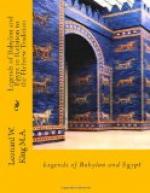(1) Herodotus, II, 171.
On the other hand, traces of myth, scattered in the religious literature of Egypt, may perhaps in some measure betray their relative age by the conceptions of the universe which underlie them. The Egyptian idea that the sky was a heavenly ocean, which is not unlike conceptions current among the Semitic Babylonians and Hebrews, presupposes some thought and reflection. In Egypt it may well have been evolved from the probably earlier but analogous idea of the river in heaven, which the Sun traversed daily in his boats. Such a river was clearly suggested by the Nile; and its world-embracing character is reminiscent of a time when through communication was regularly established, at least as far south as Elephantine. Possibly in an earlier period the long narrow valley, or even a section of it, may have suggested the figure of a man lying prone upon his back. Such was Keb, the Earth-god, whose counterpart in the sky was the goddess Nut, her feet and hands resting at the limits of the world and her curved body forming the vault of heaven. Perhaps still more primitive, and dating from a pastoral age, may be the notion that the sky was a great cow, her body, speckled with stars, alone visible from the earth beneath. Reference has already been made to the dominant influence of the Sun in Egyptian religion, and it is not surprising that he should so often appear as the first of created beings. His orb itself, or later the god in youthful human form, might be pictured as emerging from a lotus on the primaeval waters, or from a marsh-bird’s egg, a conception which influenced the later Phoenician cosmogeny. The Scarabaeus, or great dung-feeding beetle of Egypt, rolling the ball before it in which it lays its eggs, is an obvious theme for the early myth-maker. And it was natural that the Beetle of Khepera should have been identified with the Sun at his rising, as the Hawk of Ra represented his noonday flight, and the aged form of Attun his setting in the west. But in all these varied conceptions and explanations of the universe it is difficult to determine how far the poetical imagery of later periods has transformed the original myths which may lie behind them.
As the Egyptian Creator the claims of Ra, the Sun-god of Heliopolis, early superseded those of other deities. On the other hand, Ptah of Memphis, who for long ages had been merely the god of architects and craftsmen, became under the Empire the architect of the universe and is pictured as a potter moulding the world-egg. A short poem by a priest of Ptah, which has come down to us from that period, exhibits an attempt to develop this idea on philosophical lines.(1) Its author represents all gods and living creatures as proceeding directly from the mind and thought of Ptah. But this movement, which was more notably reflected in Akhenaton’s religious revolution, died out in political disaster, and the original materialistic interpretation of the




